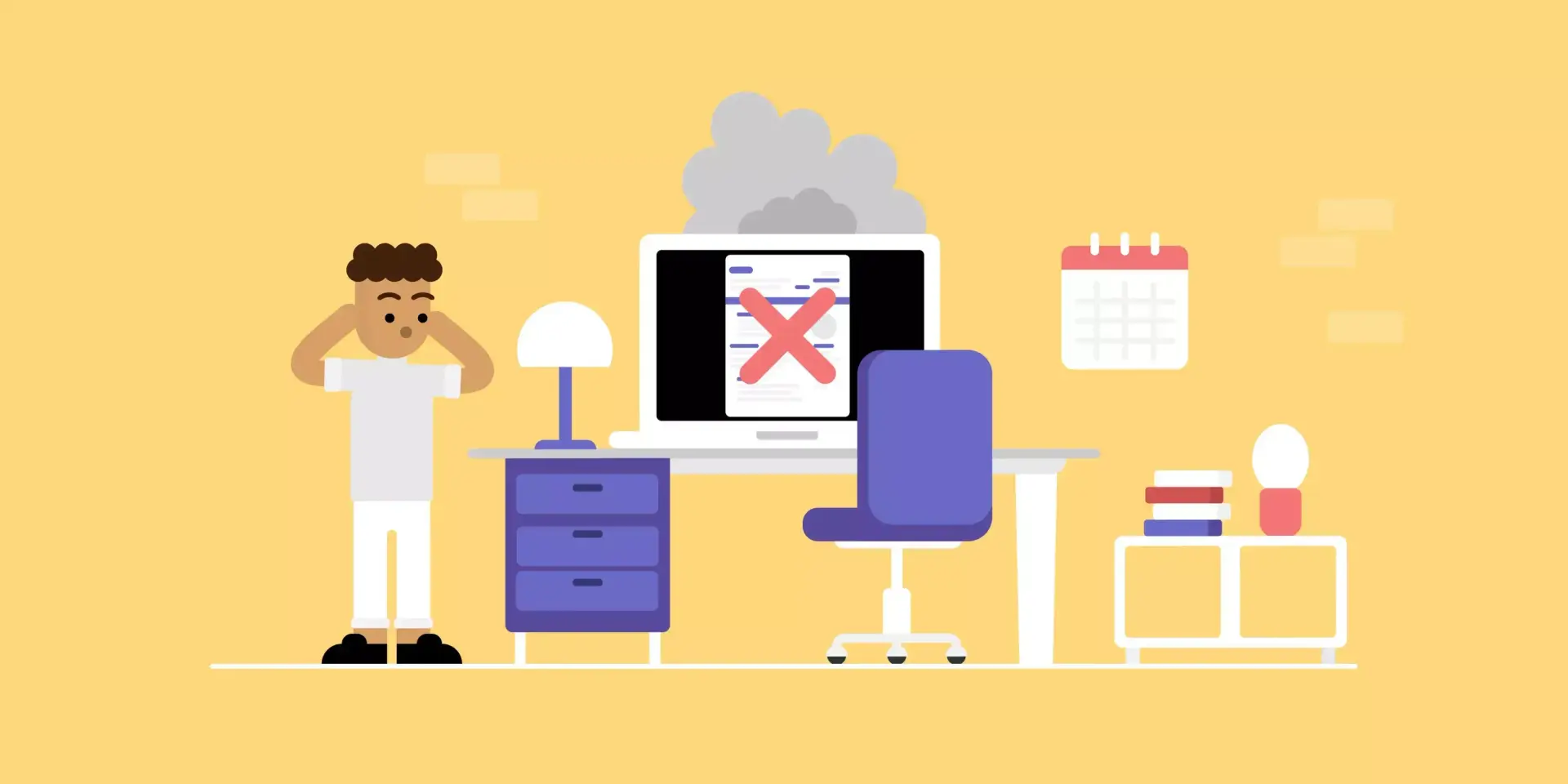
They say that to err is human, but some mistakes you’re definitely better off avoiding - especially when it comes to your resume!
From grammatical and spelling mistakes to using the wrong font and submitting a 3-page-long resume, certain mistakes make really bad resumes.
And, it goes without saying, that submitting such a resume can seriously harm your chances of getting hired, if not ruin them completely.
To keep you from making such mistakes - and also give you a good laugh - we’ve put together some bad resume examples that you must avoid at all costs, as well as a thorough explanation of what makes a good resume and a bad resume.
So, let’s dive right in!
Good Resume Vs Bad Resume
Before we dive into the most common resume mistakes, we should cover a very important topic:
What’s a good resume, and what’s a bad resume?
Here are the qualities that differentiate the two:
A Good Resume
- Is easy to skim through
- Can pass applicant tracking systems
- Is free of spelling and grammar errors
- Is ideally no longer than one-page
- Is tailored to the specific job position
- Is focused on the applicant’s skills and achievements
- Uses a professional font and has a simple layout
- Includes a resume summary or objective
A Bad Resume
- Is disorganized and difficult to read
- Has spelling and grammar mistakes
- Includes distracting graphics
- Includes an unprofessional email address
- Has long chunks of text instead of bullet points
- It is not tailored to the job position
- Is not matched with a cover letter
- Is not tailored to the position
- Includes non-quantifiable achievements
10+ Examples of Bad Resumes
It’s one thing for someone to tell you about resume mistakes and another to see them in all their glory for yourself.
To give you a better idea of how detrimental some mistakes can be to your resume, we’ve collected some of the “best” examples of bad resumes out there, starting with:
#1. Uninspired Work Experience

The work experience section is arguably the most important section of your resume, as it can effectively prove you’ve got the right experience and qualifications to do the job.
For that to happen, however, simply listing your work responsibilities won’t cut it. On the contrary, your resume must be packed with as many data-backed achievements as possible.
Well, the resume example above definitely fails to do that. Actually, it does the exact opposite - it’s an uninspired and overly generic listing of work responsibilities that recruiters already know.
None of what this applicant has listed under their work entry demonstrates how they mastered or excelled at their job, giving recruiters zero incentive to call them back for an interview.
For example, this entry here:
Incorrect Example
- Lead Generation
Gives the hiring manager exactly 0 information on what you did at the job. Sure, you generated leads, but how many? How often? Were they quality?
If phrased like this, however:
Correct Example
- Ran Google Ads campaigns, generating over 200 leads per month for our in-house software.
Then the work experience entry becomes a lot more impressive.
If you’re having trouble writing an achievement-oriented work experience section, you can also follow the Laszlo Bock formula: “Accomplished [X] as measured by [Y] by doing [Z].”
This is what this formula looks like in practice:
Right Example:
- Sourced qualified candidates utilizing various web technologies, social media, resume databases, and referrals from networking events while reducing hiring costs by 35%.
#2. Bad Spelling
Spelling or grammar mistakes can be very, very harmful to your job search.
Such mistakes tell the recruiter that you either don’t know the language very well, don’t have much attention to detail, or you don’t care much about the job you’re applying for in the first place.
So, make sure to run your resume through a friend to catch any obvious grammar or spelling mistakes.
We also recommend you try Grammarly, a very handy tool for catching mistakes.
#3. Wrong Design and Layout
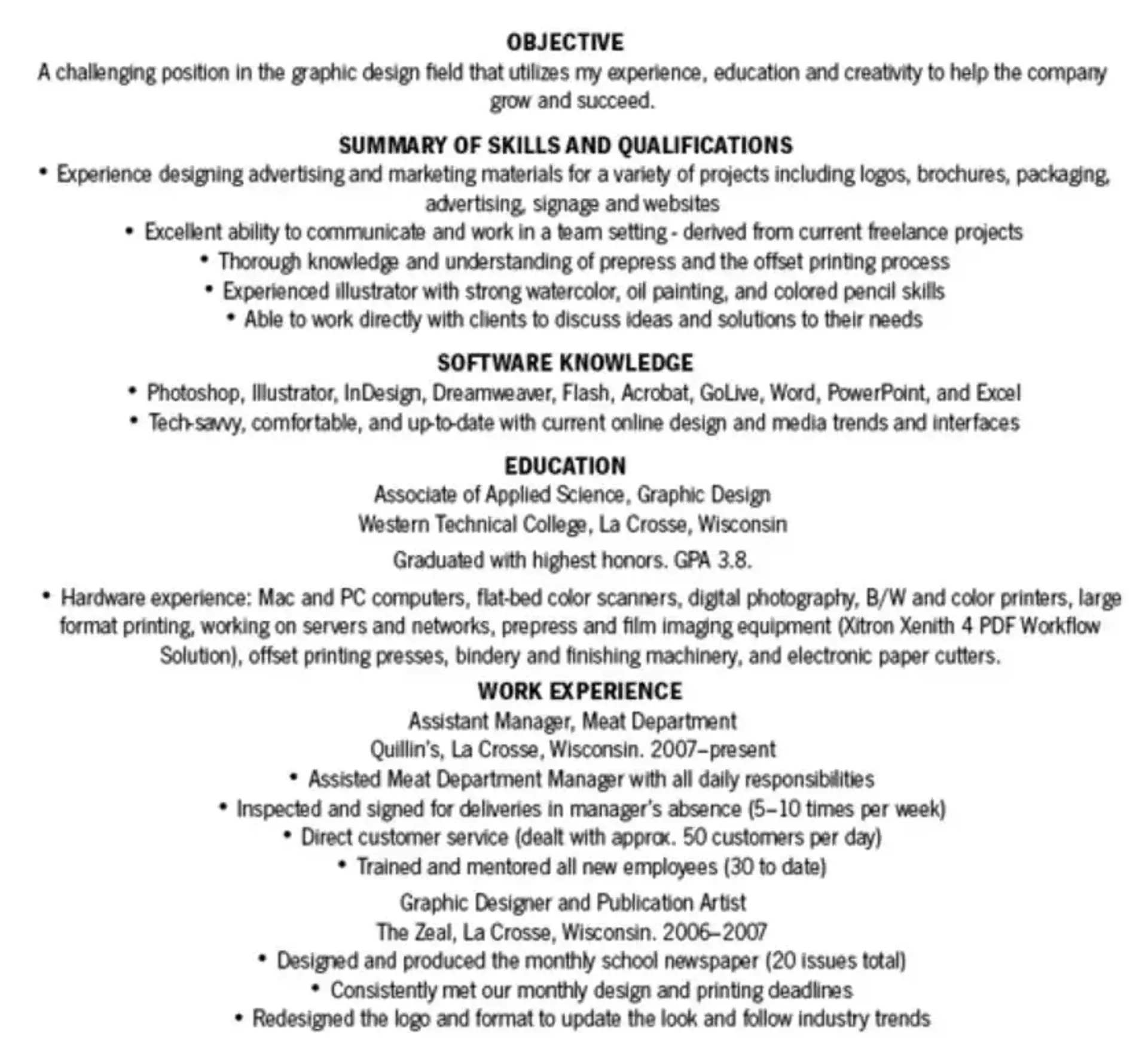
When it comes to your resume, looks matter.
Recruiters usually have hundreds of resumes they need to go through before deciding on whom to call back. The above resume example is so unimpressionable that, chances are, the recruiter won’t even notice it.
Want to avoid making the same mistake?
Follow these formatting tips:
- Font size. Your font size should be big enough to read but small enough so that the text doesn’t spill over on page #2. As such, 12 pts is usually a good font size for resumes.
- Line spacing. The line spacing should be between 1 and 1.5 to save you space.
- Section headers. To differentiate between sections, use headers for the section titles instead of using the same font size and simply bolding them (like the bad example above). That will only make all the sections look like they’re blended together, which is the opposite of reader-friendly.
Now, the bad resume example we just covered made mistakes with all 4 of these. By centering their entire resume text, they’ve messed up with the margins, the section headers, and the overall aesthetic of their resume - something recruiters are bound to notice.
If you never want to have to worry about any of these things, just use our resume builder! It’s free, easy to get the hang of, and loved by recruiters worldwide!

#5. Unprofessional Fonts
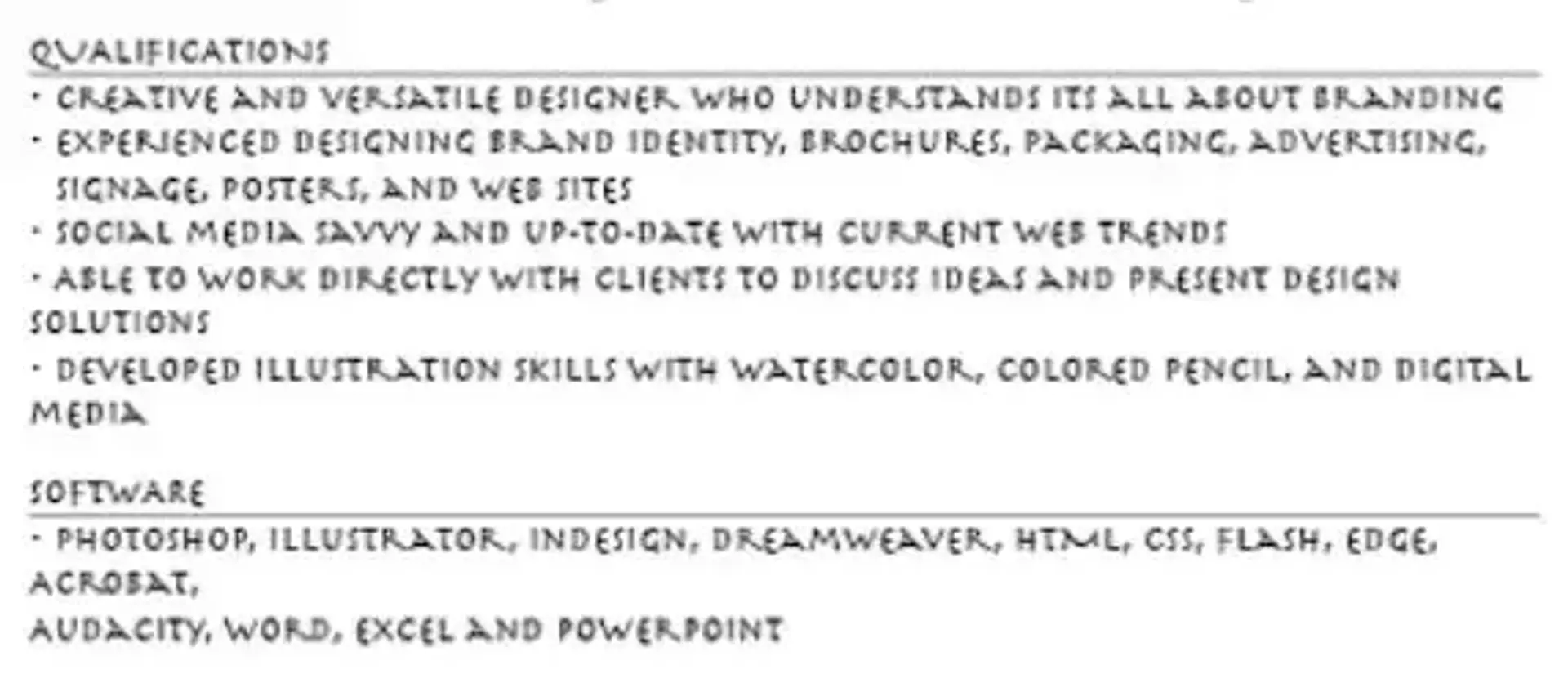
Take a long, hard look at the resume example above.
In addition to being very hard to read, it’s also very unprofessional. If a recruiter sees a resume with a font like this, they’ll simply assume that the candidate is not serious about the job.
So, instead of experimenting with your resume, stick to tried-and-tested resume-friendly fonts like Ubuntu, Roboto, and Overpass.
#7. Too Many Graphics
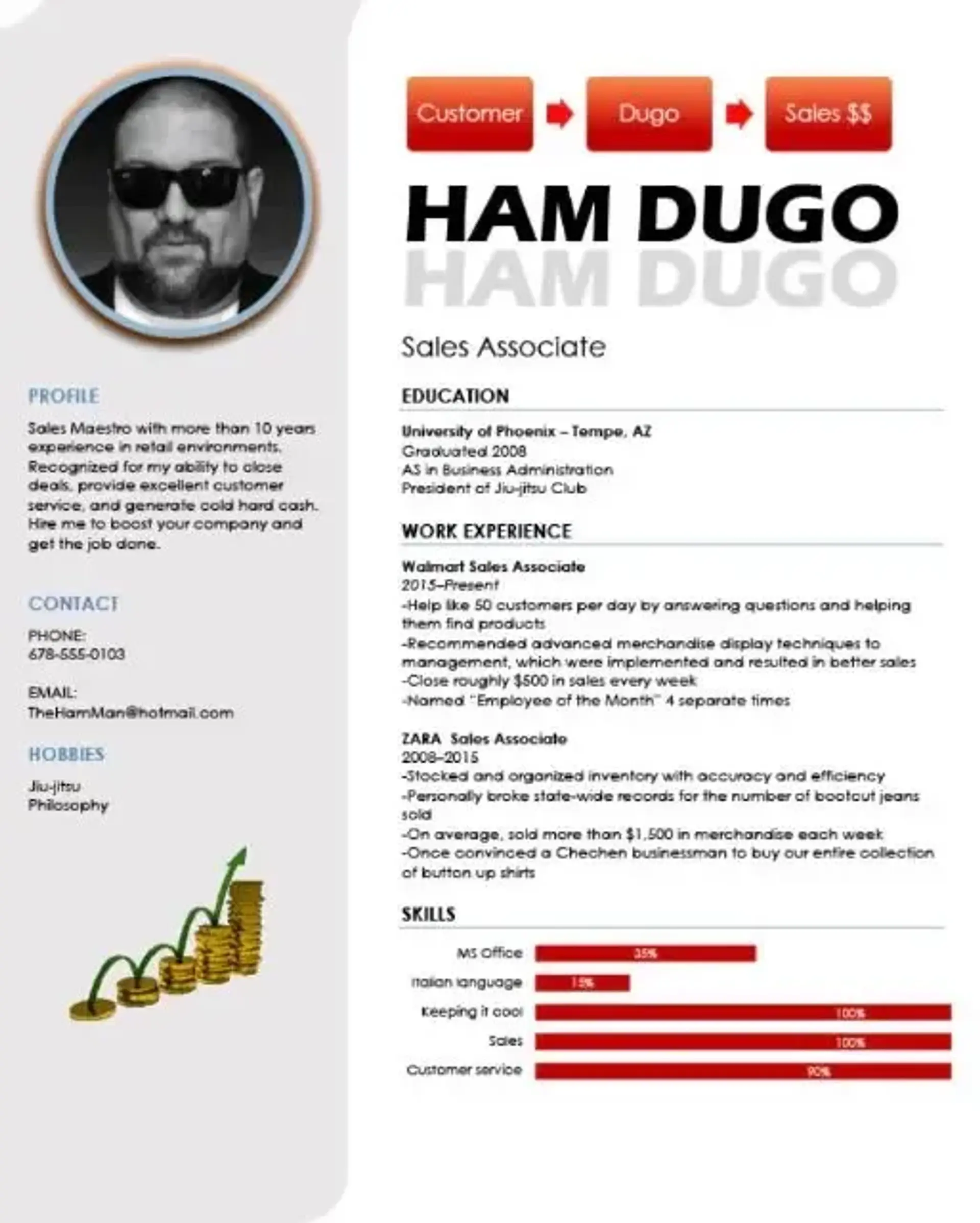
This infamous resume example uses so many graphics it simply becomes unprofessional (as well as unpleasant to look at)
Don’t get us wrong, creative resume designs aren’t all bad. Done right, they can help you stand out, catch the recruiter’s attention, and land a job you’ll love.
But even creativity has a limit. When you overuse creative elements on your resume you risk distracting recruiters from what really matters on your resume - your achievements, experiences, and most important skills.
Want a creative resume that’s not too much? Consider using a pre-designed resume template.
At Novorésumé, we offer a variety of templates to choose from that are creative, professional, and look much better than the average black-and-white template.
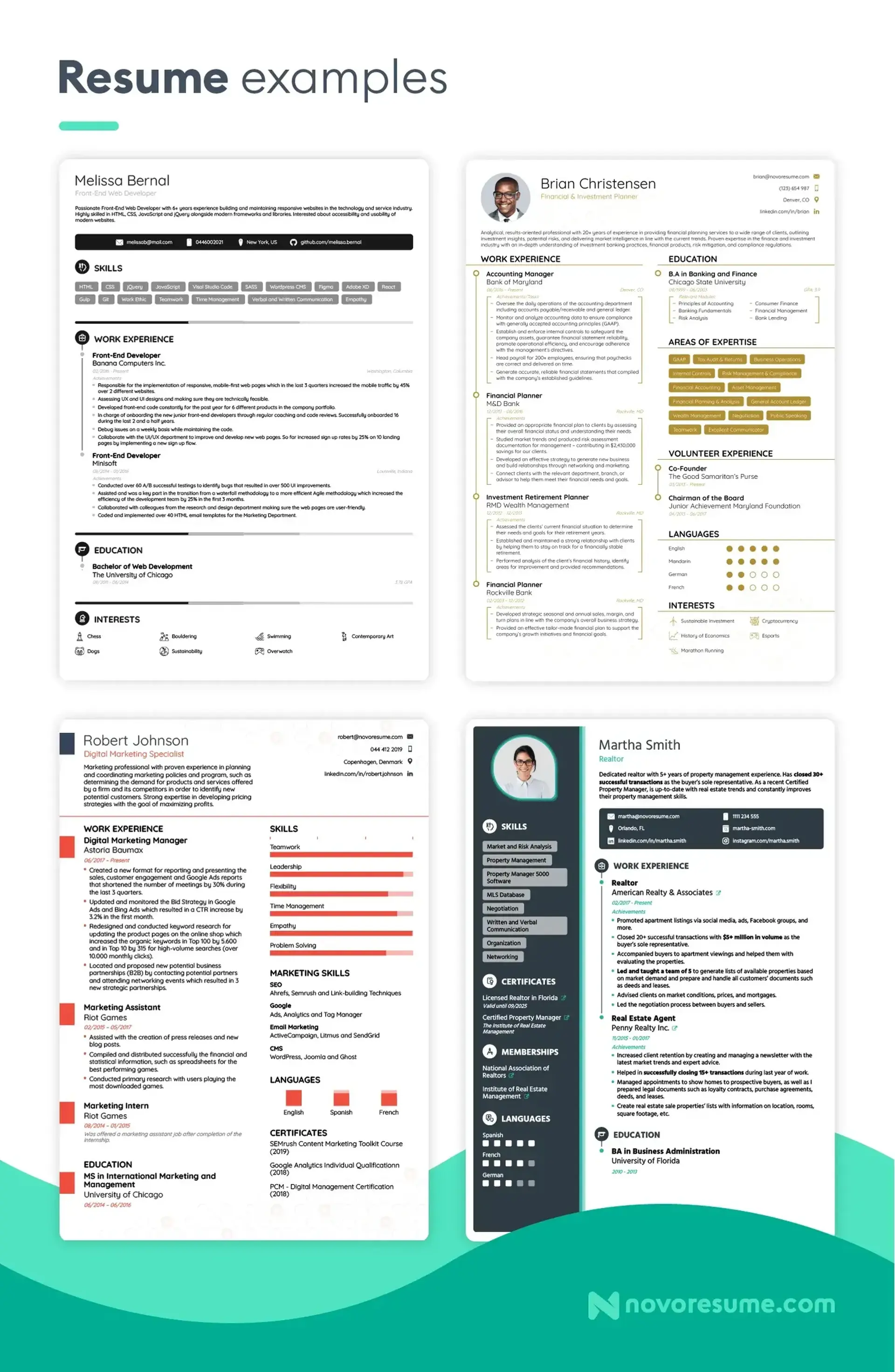
And the best part? Most of the are free! Head over here to browse our resume templates.
#8. Unimpressive Resume Summary

The resume summary is the first thing recruiters see when looking at your resume.
If the summary matches what they’re looking for, they’re going to go ahead and read the rest of your resume.
If it doesn't, though, they’ll simply skip it.
As such, it’s important for your resume summary to be memorable and captivating - unlike the example that we showed you above.
Specifically, the resume summary above is wrong because it:
- Is low-effort. It’s obvious that this candidate does not really care where they’ll get hired.
- Not tailored to the company or the role. Customizing your resume summary for the role means that you’re enthusiastic about working at this specific company, and aren’t just applying for random jobs.
- Is not specific enough. The resume summary does not include critical information like the exact years of experience, top skills, and biggest achievements.
To really drive the point home, let’s compare these 2 resume summaries:
Correct Example
Professional marketer manager with 5+ years of experience in digital marketing. Social media marketing experience, including Facebook, Google, and LinkedIn advertising. Experience in managing a Google Ads account with a monthly spend of $30,000. B.A. in marketing management.Incorrect Example
Journalist looking to work for your newspaper and put extensive journalistic experience to use. Passionate about investigating and amazing with words.
If you were the hiring manager, which one would you pick?
#9. Unprofessional Headshot
If you decide to include a picture on your resume, you’ve got to make sure that it’s actually a good idea in the first place.
Companies based in certain countries like the US, UK, or Ireland actively discourage candidates from using photos in their resumes because of anti-discrimination laws.
So, if you’re based in any of these countries, there’s a chance that including your photo in your resume might just get your application discarded immediately.
In case you don’t live in any of these countries and still want to use a photo in your resume, then you need to make sure that it’s not something from your:
- Social media profiles
- Old family scrapbooks
- High school yearbook
Rather, the photo should be:
- High-quality
- Taken by someone else (not a selfie)
- Professional-looking. You don’t need to wear a suit and tie, but a shirt would do you good
#10. Longer Than One Page When Not Necessary
Unless you have over 5-10 years of super relevant work experience, there is absolutely no reason for your resume to be longer than one page.
See, your resume should only include information relevant to the job you’re applying for.
You can skip out all sorts of irrelevant details like your first internship, your part-time summer gig, where you went to high school, and so on.
If you do so, then chances are, your resume simply won’t exceed one page.
That said, if you DO have a lot of work experience, are an executive, or work in academia, then your resume CAN be longer than a single page.
FAQs on Bad Resumes
Do you still have some questions on exactly what makes a bad resume?
We’ve gathered the most frequently asked questions (that we haven’t addressed yet) and answered them below:
Key Takeaways
And that’s a wrap!
After this article, you’ll know what a bad resume looks like when you see one (even if it’s your own). Before you go, here’s a quick recap of the most important points we covered in this article:
- Your work experience section is one of the most essential parts of your resume. Make sure your experiences are achievement-oriented and in-depth.
- Make sure your resume is spelling or grammar-free by getting a friend to review it or using a tool like Grammarly.
- Keep your resume brief - one page is enough unless you’ve got a decade’s worth of work experience.
- Some common resume mistakes involve adding an unprofessional headshot to your resume, writing a generic resume summary, and lying about your achievements.
